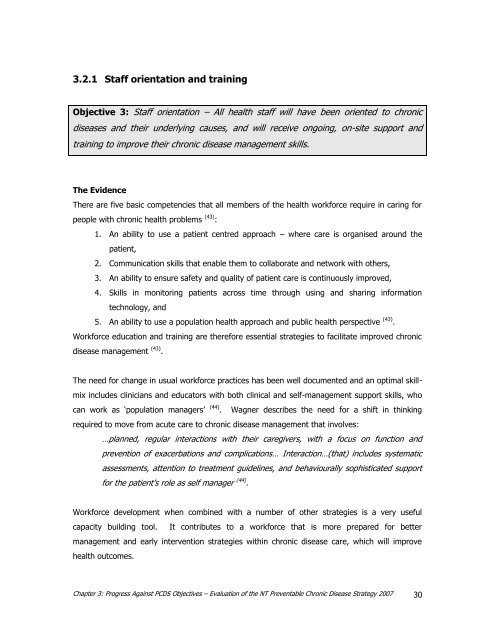PCD Strategy Evaluation 2007.pdf - NT Health Digital Library ...
PCD Strategy Evaluation 2007.pdf - NT Health Digital Library ...
PCD Strategy Evaluation 2007.pdf - NT Health Digital Library ...
You also want an ePaper? Increase the reach of your titles
YUMPU automatically turns print PDFs into web optimized ePapers that Google loves.
3.2.1 Staff orientation and trainingObjective 3: Staff orientation – All health staff will have been oriented to chronicdiseases and their underlying causes, and will receive ongoing, on-site support andtraining to improve their chronic disease management skills.The EvidenceThere are five basic competencies that all members of the health workforce require in caring forpeople with chronic health problems (43) :1. An ability to use a patient centred approach – where care is organised around thepatient,2. Communication skills that enable them to collaborate and network with others,3. An ability to ensure safety and quality of patient care is continuously improved,4. Skills in monitoring patients across time through using and sharing informationtechnology, and5. An ability to use a population health approach and public health perspective (43) .Workforce education and training are therefore essential strategies to facilitate improved chronicdisease management (43) .The need for change in usual workforce practices has been well documented and an optimal skillmixincludes clinicians and educators with both clinical and self-management support skills, whocan work as „population managers‟ (44) . Wagner describes the need for a shift in thinkingrequired to move from acute care to chronic disease management that involves:…planned, regular interactions with their caregivers, with a focus on function andprevention of exacerbations and complications… Interaction…(that) includes systematicassessments, attention to treatment guidelines, and behaviourally sophisticated supportfor the patient‟s role as self manager (44) .Workforce development when combined with a number of other strategies is a very usefulcapacity building tool. It contributes to a workforce that is more prepared for bettermanagement and early intervention strategies within chronic disease care, which will improvehealth outcomes.Chapter 3: Progress Against <strong>PCD</strong>S Objectives – <strong>Evaluation</strong> of the <strong>NT</strong> Preventable Chronic Disease <strong>Strategy</strong> 2007 30
















